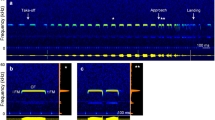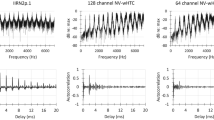Summary
-
1.
The inferior colliculus of 8 Greater Horseshoe bats (Rhinolophus ferrumequinun) was systematically sampled with electrode penetrations covering the entire volume of the nucleus. The best frequencies and intensity thresholds for pure tones (Fig. 2) were determined for 591 neurons. The locations of the electrode penetrations within the inferior colliculus were histologically verified.
-
2.
About 50% of all neurons encountered had best frequencies (BF) in the frequency range between 78 and 88 kHz (Table 1, Fig. 1A). Within this frequency range the BFs between 83.0 and 84.5 kHz were overrepresented with 16.3% of the total population of neurons (Fig. 1B). The frequencies of the constant frequency components of the echoes fall into this frequency range.
-
3.
The representation of BFs expressed as number of neurons per octave shows a striking correspondence to the nonuniform innervation density in the afferent innervation of the basilar membrane (Bruns and Schmieszek, in press). The high innervation density of the basilar membrane in the frequency band between 83 and 84.5 kHz coincides with the maximum of the distribution of number of neurons per octave across frequency in the inferior colliculus (Fig. 1 C).
-
4.
The disproportionate representation of frequencies in the auditory system of the greater horseshoe bat is described as an acoustical fovea functioning in analogy to the fovea in the visual system. The functional importance of the Doppler-shift compensation for such a foveal mechanism in the auditory system of horseshoe bats is related to that of tracking eye movements in the visual system.
Similar content being viewed by others
Abbreviations
- BF :
-
best frequency
- CF :
-
constant frequency
- DSC :
-
Doppler-shift compensation
- FM :
-
frequency modulated
References
Bruns, V.: Peripheral auditory tuning for fine frequency analysis by the CF-FM bat,Rhinolophus ferrumequinum. I. Mechanical specialization of the cochlea. J. Comp. Physiol.106, 77–86 (1976a)
Bruns, V.: Peripheral auditory tuning for fine frequency analysis by the CF-FM bat,Rhinolophus ferrumequinum. II. Frequency mapping in the cochlea. J. Comp. Physiol.106, 87–97 (1976b)
Bruns, V., Schmieszek, E.: Regional differentiations of the innervation pattern of the cochlea of the Greater Horseshoe bat. (in press) (1979)
Goldman, L.J., Henson, O.W.: Prey recognition and selection by the constant frequency bat,Pteronotusp. parnellii. Behav. Ecol. Sociobiol.2, 411–419 (1977)
Grinnell, A.D.: Neural processing mechanisms in echolocating bats, correlated with differences in emitted sounds. J. Acoust. Soc. Am.54, 147–155 (1973)
Harnischfeger, G.: An improved method for extracellular marking of electrode tip positions in nervous tissue. J. Neurosci. Meth., (in press) (1979)
Henson, O.W., Jr., Goldman, L.J.: Prey detection and physiological aspects of the cochlea in the bat,Pteronotus p. parnellii. Anat. Rec.184, 425 (1976)
Long, J.R., Schnitzler, H.-U.: Behavioural audiograms from the bat,Rhinolophus ferrumequinum. J. Comp. Physiol.100, 211–219 (1975)
Möller, J., Neuweiler, G., Zöller, H.: Response characteristics of inferior colliculus neurons of the awake CF-FM bat,Rhinolophus ferrumequinum. I. Single-tone stimulation. J. Comp. Physiol.125, 217–225 (1978)
Neuweiler, G.: Neurophysiologische Untersuchungen zum Echoortungssystem der Großen HufeisennaseRhinolophus ferrumequinum Schreber, 1774. Z. Vergl. Physiol.67, 237–306 (1970).
Neuweiler, G., Vater, M.: Response pattern to pure tones of cochlear nucleus units in the CF-FM bat,Rhinolophus ferrumequinum. J. Comp. Physiol.115, 119–133 (1977)
Pollak, G., Henson, O.W., Jr., Novick, A.: Cochlear microphonic audiograms in the “pure tone” batChilonycteris parnellii parnellii. Science176, 66–68 (1972)
Pollak, G., Schuller, G.: Tonotopic organization and response patterns to frequency modulated signals in the inferior colliculus of Horseshoe bats. Soc. Neurosci. Abstr.4, 9 (1978)
Schlegel, P.: Directional coding by binaural brainstem units of the CF-FM bat,Rhinolophus ferrumequinum. J. Comp. Physiol.118, 327–352 (1977)
Schnitzler, H.-U.: Discrimination of thin wires by flying horseshoe bats (Rhinolophidae). In: Animal sonar systems, Vol. I, Busnel, R.G. (ed.), pp. 69–87. Jouy-en Josas: Laboratoire de Physiologie Acoustique 1967
Schnitzler, H.-U.: Die Ultraschall-Ortungslaute der HufeisenFledermäuse (Chiroptera, Rhinolophidae) in verschiedenen Orientierungssituationen. Z. Vergl. Physiol.57, 376–408 (1968)
Schnitzler, H.-U.: Echoortung bei der FledermausChilonycteris rubiginosa. Z. Vergl. Physiol.68, 25–38 (1970)
Schnitzler, H.-U.: Control of Doppler-shift compensation in the Greater Horseshoe bat,Rhinolophus ferrumequinum. J. Comp. Physiol.82, 79–92 (1973)
Schnitzler, H.-U.: Die Detektion von Bewegungen durch Echoortung bei Fledermäusen. Verh. Dtsch. Zool. Ges.1978, 16–33 (1978)
Schuller, G.: Echoortung beiRhinolophus ferrumequinum mit frequenzmodulierten Lauten. Evoked potentials im Colliculus inferior. J. Comp. Physiol.77, 306–331 (1972)
Schuller, G.: Coding of small sinusoidal frequency and amplitude modulations in the inferior colliculus of ‘CF-FM’ bat,Rhinolophus ferrumequinum. Exp. Brain Res.34, 117–132 (1979)
Schuller, G., Beuter, K., Schnitzler, H.-U.: Response to frequency shifted artificial echoes in the batRhinolophus ferrumequinum. J. Comp. Physiol.89, 275–286 (1974)
Simmons, J.A.: The resolution of target range by echolocating bats. J. Acoust. Soc. Am.54, 157–173 (1973)
Simmons, J.A.: Response of the Doppler echolocation system in the bat,Rhinolophus ferrumequinum. J. Acoust. Soc. Am.56, 672–682 (1974)
Simmons, J.A., Howell, D.J., Suga, N.: Information content of bat sonar echoes. Am. Sci.63, 204–215 (1975)
Simmons, J.A., Fenton, M.B., O'Farrell, M.J.: Echolocation and Pursuit of Prey by bats. Science203, 16–21 (1979)
Suga, N.: Specialization of the auditory system for reception and processing of species-specific sounds. Fed. Proc.37, 2342–2354 (1978)
Suga, N., Jen, Ph.H.-S.: Disproportionate tonotopic representation for processing CF-FM sonar signals in the mustache bat auditory cortex. Science194, 542–544 (1976)
Suga, N., Jen, Ph.H.-S.: Further studies on the peripheral auditory system of ‘CF-FM’ bats specialized for fine frequency analysis of Doppler-shifted echoes. J. Exp. Biol.69, 207–232 (1977)
Suga, N., O'Neill, W.E.: Mechanisms of echolocation in bats: comments on the neuroethology of the biosonar system of ‘CF-FM’ bats. Trends Neurosci.1, 35–38 (1978)
Suga, N., Simmons, J.A., Jen, Ph.H.-S.: Peripheral specialization for fine frequency analysis of Doppler-shifted echoes in the auditory system of the CF-FM batPteronotus parnellii. J. Exp. Biol.63, 161–192 (1975)
Suga, N., Neuweiler, G., Möller, J.: Peripheral auditory tuning for fine frequency analysis of the CF-FM bat,Rhinolophus ferrumequinum. IV. Properties of peripheral auditory neurons. J. Comp. Physiol.106, 111–125 (1976)
Author information
Authors and Affiliations
Additional information
Supported by the Alexander von Humboldt Foundation, grant to G. Pollak; by Stiftung Volkswagenwerk, AZ.: 111858 and by the Deutsche Forschungsgemeinschaft, grants No. Schu 390/1,2 and Br 593/2
The encouragement and suggestions of Gerhard Neuweiler (University Frankfurt) and the suggestions of Bill Giesler (University of Texas) are gratefully acknowledged.
Rights and permissions
About this article
Cite this article
Schuller, G., Pollak, G. Disproportionate frequency representation in the inferior colliculus of doppler-compensating Greater Horseshoe bats: Evidence for an acoustic fovea. J. Comp. Physiol. 132, 47–54 (1979). https://doi.org/10.1007/BF00617731
Accepted:
Issue Date:
DOI: https://doi.org/10.1007/BF00617731




